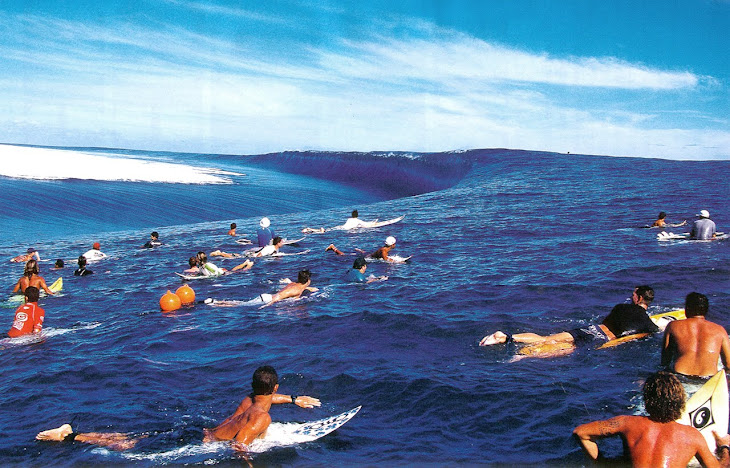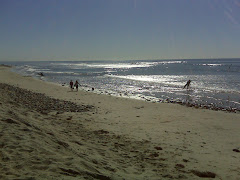
"Do you think it is harder for women in the line up then men?" Being the only one most days- I often get men looking to see if I can catch a wave, does it put pressure on me- some times- other times I just don't care- do my thing. I did notice the stares tho, and when a man can't surf well I notice they move far away from me!
Nah..Just smile :-), share aloha, share waves, amazing what happens!
For us women it is harder for sure.
Once we paddle out they size us up, if the first wave we catch isn’t our best then they lose respect and make it tough for us the whole session.
Also I think the fact that the guys stare at our body parts makes it uncomfortable~
Opportunities for Women
Many women are hitting the beaches thanks to pro influences that have helped promote surfing. The introduction of professional surfing equipment for the ladies, too, has helped advance the cause; for example, the twin-fin board was designed to be lightweight, compact and easier to turn than the single fin.
Above all, though, it’s been the professional women surfers themselves who have been mainly responsible for a change in public attitude. Two top examples are Jericho Poppler of Long Beach, California and Rell Sunn, who started surfing at age 4, of Makaha Beach, Hawaii. In the mid 60’s, people both thought these ladies were ‘strange,’ competing in an almost totally male-dominated sport.
Strange or not, Jericho won the 1970 U.S. Women’s Champion and 1976 World Champion. And Rell, “The Queen of Makaha,” became Hawaii’s number one woman-amateur surfer for five years, joined first women’s pro tour in 1975. Both these ladies were responsible for getting women’s professional surfing underway.
Growth of professionalism in their surfing industry meant they needed to travel and network, sharing their world views with worldwide audiences, winning public support.
Both dynamic ladies, Jericho and Rell Sunn became known as ‘excellent ambassadors of surfing,’ and also champions for preserving the ocean environment.
Today female surfers, just like their male counterparts, embrace surfing worldwide.
And just like the men, their skills range from amateur to accomplished professional levels, as they compete for cash prizes and corporate sponsorships in the same manner.
There is a large market for women’s clothing and equipment, for instance. With the major companies branching off and creating women’s lines, you have Roxy, Rip Curl Girl and Billabong Girl, as well as many others. The results have meant more opportunities for sponsorships and earning income – and increased amounts—from surfing.
Male-infested waters
As women are urged to hit the waves for this year's Girls Go Surfing weekend, Katie Toms warns of the perils of making it to the top
* Buzz up!
* Digg it
* Katie Toms
* The Guardian, Friday 24 June 2005
* Article history
When Layne Beachley, six times women's world champion surfer, became the first woman to enter the Australian Open last year, there was uproar both in the surfing world and the media. Despite insisting that she was competing merely to improve her performance, Beachley found her top male rival, Andy Irons, attacking her in the press and openly worrying that his masculinity would be on the line if she beat him. Surfermag, one of the sport's leading publications, was driven to ask: "Is Layne taking the spot of a more deserving male surfer?"
Women's professional surfing is a multimillion pound industry with some of the most lucrative merchandising opportunities in the world. According to the British Surfing Association (BSA), the number of amateur female surfers has gone up by more than 300% since 2002, and public interest in female surfing is increasing. Three years ago female surf movie Blue Crush took more than £27.5m at box offices worldwide, while the recent arrival of a new UK magazine, Surfgirl, further underlines a growing trend.
But despite such growth, female surfers continue to face animosity from their male counterparts. Beachley is candid about her experiences. "The guys don't like to be threatened by a girl," she says. "Andy piped up the wrong way against a little Aussie golden girl. I'm fortunate that I'm very well supported, and I think his attack was taken quite personally by the Australian public.
"It just became ridiculous, but it did bring 20,000 people to the beach for 20 minutes - which is an enormous amount of exposure for women's surfing, or for surfing generally. But as far as the guys were concerned it was just bullshit and they were threatened and they didn't appreciate the fact that I was there."
These experiences are replicated on British shores. Tracy Boxall, seven times British champion and BSA world tour coach, runs the Let's Go Surf Academy in Wales and has been offering women-only surfing weekends for eight years. Boxall has competed against male surfers on several occasions, and in 2000 was placed 5th in the British Men's Open.
"The men have a worry about getting beaten by a girl, but if they're proper males they wouldn't worry about it," she says. "I think it's fine if they want to mix the competitions: it makes the men work harder and keeps them on their toes."
To help find women a space in male-infested waters, sportswear manufacturer Ripcurl is running its third annual Girls Go Surfing event this weekend. The event offers women of all ages and abilities the chance to be coached by pro-surfers in an all-female environment. Ten surf schools across the UK - covering Cornwall, Devon, Wales, Bournemouth and Jersey - will offer coaching by qualified surf instructors, and Ripcurl pro surfer Elise Garrigue will also be on hand at Newquay's Fistral beach.
"A lot of girls are put off surfing because they have to put on a wetsuit and they don't feel comfortable walking down the beach and getting in the water with a load of guys around," says James Hendy, Ripcurl's head of UK marketing. "The whole emphasis of the Girls Go Surfing event and the reason we do it is purely because it is considered a male-oriented sport and we want to give girls the opportunity to surf with a bunch of other girls and not feel shy or embarrassed. Without someone introducing the current top female pro surfers into the sport and having an easy way like the Girls Go Surfing days, then a lot of them probably wouldn't be where they are now."
But even if they do manage to reach the world of professional surfing, these women are unlikely to be treated quite so kindly.
There are nine events in the year-long women's World Championship Tour, which came to Perranporth in Cornwall last month and also takes in Australia, Fiji, Tahiti, California and Hawaii. Showcased alongside the competition in Perranporth were female-fronted bands, coaching for women surfers, a surfing event for teenage girls and an auction of artworks made from casts of the surfers' busts in aid of breast cancer. Despite this general atmosphere of right-on girl power, however, the loudest statement made by event sponsors was in the pay packets and prize money of the women surfers.
Each of the nine events in the women's WCT carries a first prize of £5,500, with a total purse of £35,750. A pot of cash not to be sniffed at you might say - yet the men's WCT is divided into 12 events, each with prizes totalling £150,000 and a first prize of £16,500. "There's a huge discrepancy between the men's and women's prize money," says Beachley. "The way the industry has been structured, it's always been about the men."
Geoff Sykes, UK marketing manager for Roxy, the women's brand of surf label Quiksilver and sponsor of the Perranporth WCT heat, says: "The development of women's surfing has really come a long way. There never used to be a female tour, it used to be only for the men. The prize money [for men and women] has blown up proportionally - but really the money the girls win on the tour is a little bit of money for their back pocket. They make more of their money through their professional sponsorships and partnerships."
But inequality also appears in sponsorship deals, with professional female surfers generally earning around half as much as their male counterparts.
Is the answer, then, for women to bypass the inequality by competing directly against men and thereby having a chance to win equal prize money?
Hawaiian Rochelle Ballard, ranked No 2 in the WCT, thinks not. "That does not make any sense. Really, what is the point? They're competing for a world title; we're competing for a world title. Comparing ourselves is like mixing apples and oranges. It's the old way of thinking."
Some believe that the financial inequality reflects the physical limits of the female body compared to the male. In fact, Beachley sees male and female surfing as radically different. "I compare men's and women's surfing to lightweight and heavyweight boxing: they're both the same discipline, but they're very different and they require two completely different forms of participation. Men have a bigger muscle base and this affects their technique and weight dispersion - they have more power and therefore they can do a lot more. The girls are closing the gap, but the best surfer in the world as a female will never be as good as the male."
Ballard agrees: "To me, the further away we get from that comparison of men to women and appreciate the elements of feminine and masculine within their own being, that's when we'll be able to really enjoy the value of the sport."
It seems the women can catch the waves and perform the manoeuvres, but they just don't look as powerful, a quality that is hard to quantify but is at the crux of the judging criteria for professional surfing. British-based surfer Kay Holt says: "It is about how you look. They say style doesn't come into it, but I try to surf like a man," she says. "You have to change your style."
"We'll never be as strong as a man, but women surfers are probably more graceful," says Boxall. "As in any sport, men are always stronger than women with the same weight ratio - that's just part of life. The younger girls are surfing like men, but they're not as powerful as men."
So where does the power for change lie? Sponsors could make the prize money and sponsorship equal across men and women's surfing, but, instead, marketing budgets are spent on glamorous advertising campaigns. Female clothing advertisements in male surfing magazines are littered with semi-pornographic images, and most of the competitions now feature Miss World-style events as a sideshow. Ripcurl has even organised a "Bikini babes" competition alongside its Boardmaster event this August.
Catherine Higgins, marketing manager of Reef UK, whose advertising almost exclusively features thong and arse shots, says: "The bikini-clad girl is an indelible part of the beach-going experience."
It seems it is hard for the female surfers to win whether they conform to feminine stereotypes, masculine ones, or neither.














